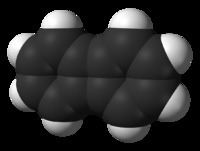Formula C12H8 Appearance solid | Molar mass 152.19 g/mol | |
 | ||
How to say biphenylene high quality voices
Biphenylene is an alternant, polycyclic hydrocarbon composed of two benzene rings joined together by a pair of mutual attachments (as opposed to a normal ring fusion), thus forming a 6-4-6 arene system. The resulting planar structure was one of the first pi-electronic hydrocarbon systems discovered to show evidence of antiaromaticity.
Contents
- How to say biphenylene high quality voices
- How to pronounce biphenylene
- Properties
- Higher Biphenylenes
- References
The biphenylene structure can also be understood as a dimer of the reactive intermediate benzyne, which in fact serves as a major synthetic route, e.g., from benzenediazonium-2-carboxylate.
How to pronounce biphenylene
Properties
Biphenylene, a pale yellowish solid with a hay-like odor, was first synthesized by Lothrop in 1941. The chemistry of biphenylene is extensive, and has been the subject of two major reviews., Biphenylene is quite stable both chemically and thermally, and behaves in many ways like a traditional polycyclic aromatic hydrocarbon. However, both the spectral and chemical properties show the influence of the central [4n] ring, leading to considerable interest in the system in terms of its degree of lessened aromaticity.
Questions of bond alternation and ring currents have been investigated repeatedly. Both X-ray diffraction and electron diffraction studies show a considerable alternation of bond lengths, with the bridging bonds between the benzenoid rings having the unusually great length of 1.524 Å. The separation of the rings is also reflected by the absence of the transmission of NMR substituent effects through the central [4n] ring. However, more sensitive NMR evidence, and particularly the shifting of proton resonances to high field, does indicate the existence of electron delocalization in the central [4n] ring., This upfield shift has been interpreted in terms of diminished benzenoid ring currents, either with or without an accompanying paramagnetic ring current in the central [4n] ring. Magnetic susceptibility measurements also show a diminishing of both diamagnetic exaltation and diamagnetic anisotropy, relative to comparable pure [4n+2] systems, which is also consistent with a reduction of ring current diamagnetism. The electronic structure of biphenylene in the gas phase has the HOMO at a binding energy of 7.8 eV.
Higher Biphenylenes
A fair number of higher polycycles containing the biphenylene nucleus have also been prepared, some having considerable antiaromatic character. In general, additional 6-membered rings add further aromatic character, and additional 4-membered and 8-membered rings add antiaromatic character. However, the exact natures of the additions and fusions greatly affect the perturbations of the biphenylene system, with many fusions resulting in counter-intuitive stabilization by [4n] rings, or destabilization by 6-membered rings. This has led to significant interest in the systems by theoretical chemists and graph theoreticians.
